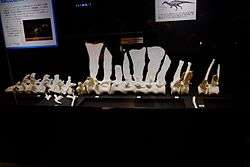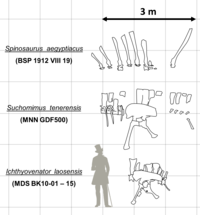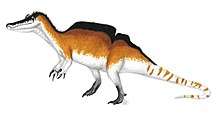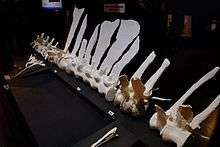Ichthyovenator
| Ichthyovenator Temporal range: Early Cretaceous | |
|---|---|
 | |
| Casts of the type vertebrae in side view | |
| Scientific classification | |
| Kingdom: | Animalia |
| Phylum: | Chordata |
| Clade: | Dinosauria |
| Order: | Saurischia |
| Suborder: | Theropoda |
| Family: | †Spinosauridae |
| Subfamily: | †Spinosaurinae |
| Genus: | †Ichthyovenator Allain et al., 2012 |
| Type species | |
| †Ichthyovenator laosensis Allain et al., 2012 | |
Ichthyovenator (meaning "fish hunter") is a genus of spinosaurid theropod dinosaur from the Early Cretaceous of Laos, likely from the Aptian age (113–125 million years ago). The animal is known from fossils collected in the Grès supérieurs Formation. Like most other members of its family, Ichthyovenator had elongated neural spines forming a "sail" on its back, although Ichthyovenator's was unusual due to it being split in two over the hips. Ichthyovenator was initially thought to belong in the Baryonychinae subfamily. However, more recent analyses place it in the Spinosaurinae.
Discovery and naming

The type species is Ichthyovenator laosensis; named and described in 2012 by Ronan Allain, Tiengkham Xeisanavong, Philippe Richir and Bounsou Khentavong. The generic name is derived from Greek ἰχθύς (ichthys), "fish", and Latin venator, "hunter", in reference to a piscivorous lifestyle. The specific name refers to the provenance from Laos.[1] It is the third spinosaurid named from Asia, after Siamosaurus in 1986, and "Sinopliosaurus" fusuiensis in 2009.[1][2][3]
Ichthyovenator is represented by a single holotype or syntype series MDS BK10-01 — 15. The fossil was found in 2010 in the Grès supérieurs Formation of the Savannakhet Basin in Savannakhet Province, in a layer which is probably Aptian in age. It consists of a partial skeleton lacking the skull. It includes the penultimate dorsal vertebra, the spine of the last dorsal vertebra, five sacral vertebrae, the first two caudal vertebrae, both ilia, both ischia, a right pubis and a posterior rib. The bones were recovered from a surface area of less than two square meters. At the time of the description, excavations at the site were still ongoing.[1]
In 2014, a Journal of Vertebrate Paleontology abstract concerning the genus was published by Allain. This abstract indicated that additional remains from the original individual have been found after an excavation in 2012. These remains include several unserrated teeth, the left pubis, and many vertebrae (including a nearly complete neck). However, this abstract has not been formally published as an academic paper as of 2018.[4] Some of these additional vertebrae were compared with the vertebrae of other spinosaurids in a 2015 paper focusing on Sigilmassasaurus.[5]
Description


In 2016, Gregory S. Paul estimated Ichthyovenator at 8.5 meters (27 ft) long and weighing 2 tonnes (2.2 short tons).[6]
The describers determined some unique derived traits, autapomorphies, of Ichthyovenator. There is a sinusoid sail present on the back and the hip. The spine of the penultimate dorsal vertebra has 410% of the height of the vertebral centrum. Its front upper edge features a finger-like process. The spines of the third and fourth sacral vertebrae are fan-shaped. The lateral processes of the first tail vertebra, when seen from above, have a sinusoid profile. The sides of first tail vertebra are deeply hollowed out between the prezygapophyses and the diapophyses. The ilium is longer compared to the pubic bone than with any other known theropod. Some additional traits are unique within the Tetanurae. The ribs of the last back vertebrae articulate with the complex of the breast bone. On the hind rim of the pubic bone, two openings, the foramen obturatum and a lower fenestra, are not fully closed, making them into notches. The main body of the ischium is large with an opening in its side. The shaft of the ischium is flattened sideways.[1]
Unlike other spinosaurids, Ichthyovenator has at least two separate sails. The preserved e, over a meter long, shows a very high spine on the penultimate, twelfth, back vertebra, representing a crest extending from the back, and a lower rounded sail extending from the sacral vertebrae of the hip, with its highest point above the third and fourth sacrals. The 546 millimeter long spine of the twelfth dorsal vertebra widens towards the top, giving it a trapezoidal shape, whereas the spines of other spinosaurids are roughly rectangular. Its front corner forms a three centimeter long narrow process, pointing upwards. The spine of the thirteenth dorsal vertebra has only been partly preserved, its upper and lower ends having broken off. From its general shape the describers inferred however, that it was about as long as the preceding spine. This would imply that the back edge of the front sail would form a rectangular corner, as the spine of the first sacral vertebra is with about twenty-one centimeters much lower, creating a sudden hiatus. The spine of the second sacral vertebra steeply curves upwards again, joining the forty-eight centimeters high broad fan-shaped spines of the third and fourth sacrals. The spine of the fifth sacral gradually descends. The sacral spines are not fused, nor have any extensive contacts.[1]
Classification


Ichthyovenator was assigned by its initial describers to Spinosauridae, more precisely to the subfamily Baryonychinae in a basal position as the sister species of a clade formed by Baryonyx and Suchomimus.[1] The 2014 abstract instead found that Ichthyovenator was part of the subfamily Spinosaurinae, due to the lack of serrations on its teeth and possession of vertebrae with some similarities to those of Sigilmassasaurus.[4][5] This conclusion was supported by Arden and colleagues in 2018, who resolved Icthyovenator as a basal member of the group due to its tall dorsal sail.[7]
Some sources have hypothesized that Ichthyovenator may not have been a spinosaurid at all, instead possibly being a sail-backed carcharodontosaurid closely related to Concavenator. However, this hypothesis has not been published in an academic environment.[8]
Below is a cladogram following the results of the 2018 analysis by Arden et al.:[7]
| Spinosauridae |
| |||||||||||||||||||||||||||||||||||||||||||||||||||
References
- 1 2 3 4 5 6 Allain, R.; Xaisanavong, T.; Richir, P.; Khentavong, B. (2012). "The first definitive Asian spinosaurid (Dinosauria: Theropoda) from the early cretaceous of Laos". Naturwissenschaften. 99 (5): 369–377. Bibcode:2012NW.....99..369A. doi:10.1007/s00114-012-0911-7. PMID 22528021.
- ↑ Buffetaut, E.; and Ingevat, R. (1986). Unusual theropod dinosaur teeth from the Upper Jurassic of Phu Wiang, northeastern Thailand. Rev. Paleobiol. 5: 217-220.
- ↑ Buffetaut, E.; Suteethorn, V.; Tong, H.; Amiot, R. (2008). "An Early Cretaceous spinosaur theropod from southern China". Geological Magazine. 145 (5): 745–748. doi:10.1017/S0016756808005360.
- 1 2 Allain, Ronan (2014). "New material of the theropod Ichthyovenator from Ban Kalum type locality (Laos): Implications for the synonymy of Spinosaurus and Sigilmassasaurus and the phylogeny of Spinosauridae". Journal of Vertebrate Paleontology Programs and Abstracts.
- 1 2 Evers, Serjoscha W.; Rauhut, Oliver W.M.; Milner, Angela C.; McFeeters, Bradley; Allain, Ronan (2015-10-20). "A reappraisal of the morphology and systematic position of the theropod dinosaur Sigilmassasaurus from the "middle" Cretaceous of Morocco". PeerJ. 3: e1323. doi:10.7717/peerj.1323. ISSN 2167-8359.
- ↑ S.,, Paul, Gregory. The Princeton field guide to dinosaurs (2nd ed.). Princeton, N.J. ISBN 9781400883141. OCLC 954055249.
- 1 2 Arden, T.M.S.; Klein, C.G.; Zouhri, S.; Longrich, N.R. (2018). "Aquatic adaptation in the skull of carnivorous dinosaurs (Theropoda: Spinosauridae) and the evolution of aquatic habits in Spinosaurus". Cretaceous Research. In Press. doi:10.1016/j.cretres.2018.06.013.
- ↑ Mortimer, Mickey (2017). "Megalosauroidea". The Theropod Database.

.jpg)
.png)